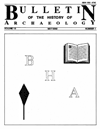Is It Worth Saving?: The Condition of Archaeological Documentary Record and Strategies for Preservation
DOI:
https://doi.org/10.5334/bha.02202Keywords:
Condition of Archaeological Documentary Record, PreservationAbstract
"[Historical] objects are events which have finished happening, and conditions [are] no longer in existence. Only when they are no longer perceptible do they become objects of historical thought" (Collingwood 1946:233).Scholars engaged in research in the history of anthropology and archaeology have long been aware of the deplorable conditions in which records as to anthropology's development in time are found and stored. All too often the researcher finds records in individual and institutional hands that are physically degrading because of the lack of proper storage facilities, the fiscal inability to hire professional archivists, the usage of improper methods of acquisition and curation, and dwindling financial resources to properly care for materials. It is now the time to ask if anthropological records are worth saving, and if they are, what are the best strategies to be employed to ensure their survival and protection now and into the future.
The purpose of this paper is to suggest that the records of the subdiscipline of archaeology are worth saving and that there is a great sense of urgency to get about the business of identification and preservation before archaeological documentary records are further destroyed due to neglect and the lack of means to ensure their future existence. This paper will define the problems of identification and preservation of archaeological records as they exist now and suggest strategies to rectify those problems.
Downloads
Published
Issue
Section
License
Copyright (c) 1992 The Author(s)

This work is licensed under a Creative Commons Attribution 4.0 International License.
Authors who publish with this journal agree to the following terms. If a submission is rejected or withdrawn prior to publication, all rights return to the author(s):
- Authors retain copyright and grant the journal right of first publication with the work simultaneously licensed under a Creative Commons Attribution License that allows others to share the work with an acknowledgement of the work's authorship and initial publication in this journal.
- Authors are able to enter into separate, additional contractual arrangements for the non-exclusive distribution of the journal's published version of the work (e.g., post it to an institutional repository or publish it in a book), with an acknowledgement of its initial publication in this journal.
- Authors are permitted and encouraged to post their work online (e.g., in institutional repositories or on their website) prior to and during the submission process, as it can lead to productive exchanges, as well as earlier and greater citation of published work (See The Effect of Open Access).
Submitting to the journal implicitly confirms that all named authors and rights holders have agreed to the above terms of publication. It is the submitting author's responsibility to ensure all authors and relevant institutional bodies have given their agreement at the point of submission.
Note: some institutions require authors to seek written approval in relation to the terms of publication. Should this be required, authors can request a separate licence agreement document from the editorial team (e.g. authors who are Crown employees).

